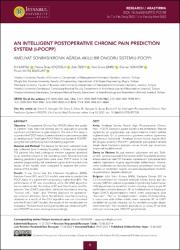| dc.contributor.author | Kartal, Elif | |
| dc.contributor.author | Koçoğlu Önay, Fatma | |
| dc.contributor.author | Özen, Zeki | |
| dc.contributor.author | Emre, İlkim Ecem | |
| dc.contributor.author | Güngör, Gürcan | |
| dc.contributor.author | Sutaş Bozkurt, Pervin | |
| dc.date.accessioned | 2022-07-04T10:54:03Z | |
| dc.date.available | 2022-07-04T10:54:03Z | |
| dc.date.issued | 2022 | en_US |
| dc.identifier.citation | Kartal E, Kocoglu FO, Ozen Z, Emre, IE, Gungor, G, Sutas Bozkurt P. An Intelligent Postoperative Chronic Pain
Prediction System (I-POCPP). J Ist Faculty Med. Published online June 13, 2022. doi: 10.26650/IUITFD.972738 | en_US |
| dc.identifier.issn | 1305-6441 | |
| dc.identifier.uri | https://hdl.handle.net/20.500.12809/10072 | |
| dc.description.abstract | Objective: Postoperative Chronic Pain (POCP) affects the quality of patients' lives. Machine learning and its applications provide significant contributions to pain research. The aim of this study is to predict the POCP status of patients based on perioperative data by developing an "Intelligent POCP Prediction System (I-POCPP)" using the best performing machine learning algorithm.
Material and Method: The dataset for this multi-centered study was collected from 5 tertiary hospitals in Turkey and included 733 patients who had undergone elective surgeries attended by an anesthesiologist in the operating room. Several machine learning prediction algorithms were used. POCP status of the patients diagnosed by the anesthesiologists and the prediction results of the models were compared to evaluate the performance of the models.
Results: It was found that the k-Nearest Neighbour (kNN), Random Forest (RF), and C5.0 models were able to predict the POCP status of a patient with an accuracy higher than 80%. The performance of RF was considered, while the kNN algorithm has no stable model. According to RF and Classification and Regression Tree (CART) algorithms' attribute importance ranking, "Incision site", "Age", and "Primary diagnosis for operation" are common attributes. Since the attribute importance ranking obtained as a result of the C5.0 algorithm was not consistent with the RF and CART models, the results of this model were not evaluated. The best result among all models was obtained by RF, and I-POCPP has been developed accordingly.
Conclusion: Fast, accurate, and efficient treatment of POCP provided by I-POCPP could allow the patient to return to daily life earlier. | en_US |
| dc.description.abstract | Amaç: Ameliyat Sonrası Kronik Ağrı (Postoperative Chronic Pain - POCP), hastaların yaşam kalitesini etkilemektedir. Makine öğrenmesi ve uygulamaları, ağrı araştırmalarına önemli katkılar sağlamaktadır. En iyi performans gösteren makine öğrenmesi algoritmasını kullanarak “Ameliyat Sonrası Kronik Ağrıda Akıllı
Bir Öngörü Sistemi (I-POCPP)” geliştirerek perioperatif verilere dayalı olarak hastaların ameliyat sonrası kronik ağrı durumunu öngörmek hedeflenmiştir.
Gereç ve Yöntem: Bu çok merkezli çalışmanın veri seti, Türkiye’deki üçüncü basamak 5 hastanede elektif koşullarda anestezi altında ameliyat olan 733 hastadan toplanmıştır. Çalışmada farklı makine öğrenmesi öngörü algoritmaları kullanılmıştır. Anestezistler tarafından tanı konulan hastaların gerçekleşen kronik ağrı
durumu ve modellerin öngörü sonuçları karşılaştırılarak modellerin performansı değerlendirilmiştir.
Bulgular: k-En Yakın Komşu (kNN), Rastgele Orman (RF) ve C5.0 modellerinin bir hastanın ameliyat sonrası kronik ağrı durumunu %80’den yüksek doğrulukla öngörebildiği bulunmuştur. kNN algoritmasının kararlı bir modeli olmadığı düşüncesiyle RF performansı dikkate alınmıştır. RF ve Sınıflandırma ve Regresyon Ağacı (CART) algoritmalarının nitelik önem sıralamasına göre “Kesi yeri”, “Yaş” ve “Ameliyat nedeni” ortaktır. C5.0 algoritması sonucunda elde edilen nitelik önem sıralaması RF ve CART
modelleri ile uyumlu olmadığı için bu modelin sonuçları değerlendirilmemiştir.
Tüm modeller arasında en iyi sonuç RF ile elde edilmiştir ve buna göre I-POCPP geliştirilmiştir.
Sonuç: I-POCPP sistemiyle sağlanan ameliyat sonrası kronik ağrının hızlı, doğru ve etkin tedavisi, hastanın günlük yaşama daha erken dönmesini sağlayabilir. | en_US |
| dc.item-language.iso | eng | en_US |
| dc.publisher | ISTANBUL UNIV | en_US |
| dc.relation.isversionof | 10.26650/IUITFD.972738 | en_US |
| dc.item-rights | info:eu-repo/semantics/openAccess | en_US |
| dc.subject | Postoperative Chronic Pain | en_US |
| dc.subject | Machine Learning | en_US |
| dc.subject | Classification | en_US |
| dc.subject | Decision Support System | en_US |
| dc.subject | Ameliyat Sonrası Kronik Ağrı | en_US |
| dc.subject | Makine Öğrenmesi | en_US |
| dc.subject | Sınıflandırma | en_US |
| dc.subject | Karar Destek Sistemi | en_US |
| dc.title | AN INTELLIGENT POSTOPERATIVE CHRONIC PAIN PREDICTION SYSTEM (I-POCPP) | en_US |
| dc.item-title.alternative | AMELİYAT SONRASI KRONİK AĞRIDA AKILLI BİR ÖNGÖRÜ SİSTEMİ (I-POCPP) | en_US |
| dc.item-type | article | en_US |
| dc.contributor.department | MÜ, Mühendislik Fakültesi, Yazılım Mühendisliği Bölümü | en_US |
| dc.contributor.authorID | 0000-0002-1096-9865 | en_US |
| dc.contributor.institutionauthor | Koçoğlu Önay, Fatma | |
| dc.relation.journal | JOURNAL OF ISTANBUL FACULTY OF MEDICINE-ISTANBUL TIP FAKULTESI DERGISI | en_US |
| dc.relation.publicationcategory | Makale - Uluslararası Hakemli Dergi - Kurum Öğretim Elemanı | en_US |


















